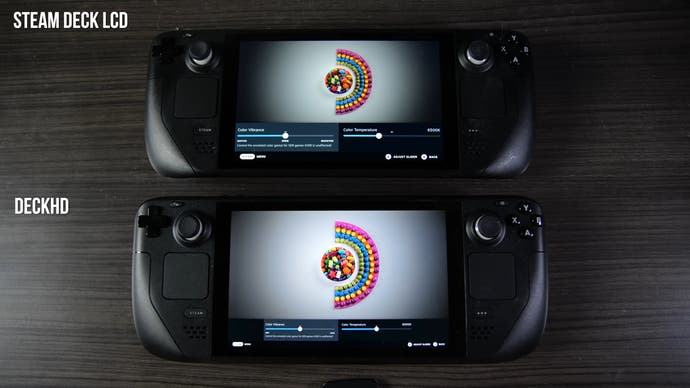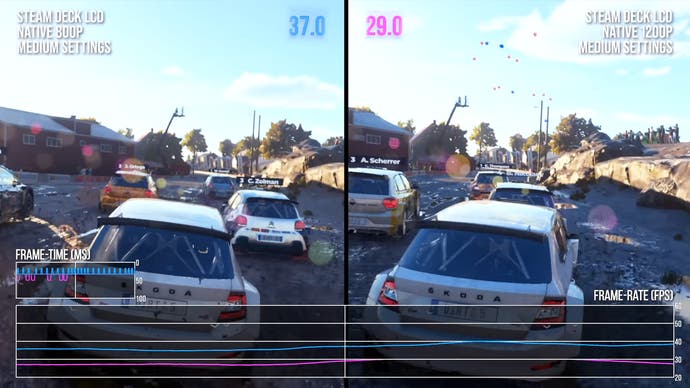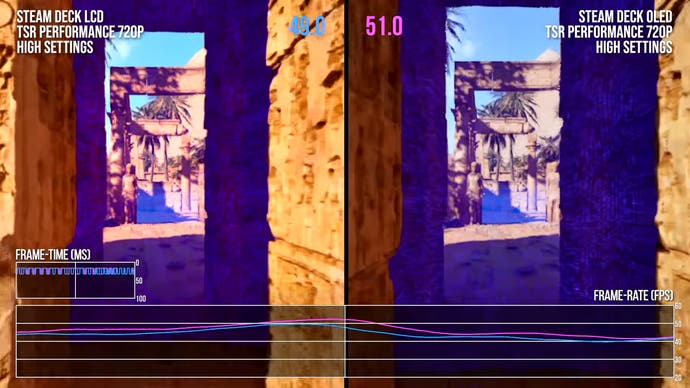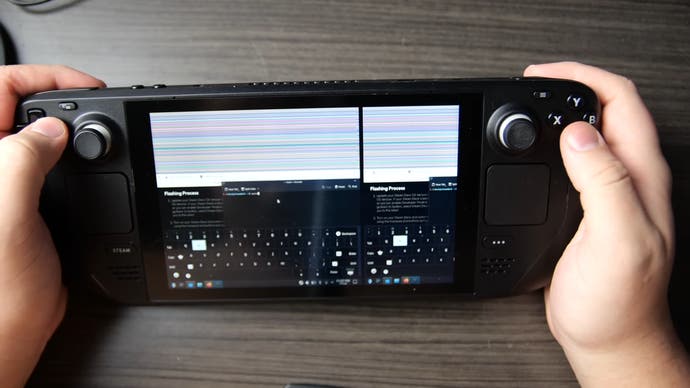The DeckHD is a thoughtful but flawed screen upgrade versus Steam Deck OLED
Yet this 1200p display upgrade kit still serves a purpose in 2024.
Valve's Steam Deck garnered almost universal acclaim when it launched in 2022. It offered a powerful handheld experience, with well-designed software and plenty of hardware power. The screen, however, left something to be desired, with low contrast, poor colour reproduction and a decent amount of display lag. You could of course upgrade to Valve's Steam Deck OLED, which comprehensively solves those issues, or opt for a full display replacement in the form of the DeckHD, which offers a higher resolution and higher-quality LCD panel. Today we'll be evaluating each of those two options to see which upgrade path works best for original Steam Deck users.
First, let's take a deep-dive into the DeckHD. This is a $99 USD display replacement that's available for the original Steam Deck - aka Steam Deck LCD - and should be a higher-quality LCD panel with fewer weaknesses than the default screen. The DeckHD unit was provided to us fully assembled for the purposes of this review, but it's worth noting that you'd need to install the screen yourself if you were buying one.
With both devices set to the same settings and set side-by-side at 50 percent brightness, the main difference you'll notice is that screen elements appear smaller on the DeckHD due to its higher resolution of 1920x1200 versus 1280x800 on the Deck - though this can be altered if you like. Having 2.3x the pixels makes a big difference while gaming, although of course this comes at a performance penalty as we'll see later.
Taking a closer look with a colourimeter, you can see that the DeckHD panel produces a warmer tone while the original Deck is a little cooler, with some subtle purple tones appearing in depictions of sky on the DeckHD that don't appear on the original Deck display. The DeckHD can actually reproduce more of the sRGB gamut according to the distributor - 87 percent versus around 70 percent for the original deck - but both are reasonably well-calibrated, I think it's fair to say.
When I pushed panel brightness to the max on both devices, the DeckHD appeared slightly dimmer, but not by much. The DeckHD has a matte screen coating, which should help to diminish glare, which isn't quite to my tastes but I know some users quite like. Image contrast also appeared stronger on the original unit slightly, which could be partly a byproduct of that matte screen. Off-axis viewing did look slightly better on my DeckHD unit however, with brighter colour at steep viewing angles.
There's one last display issue that I wanted to note here, which I noticed on my DeckHD unit. There are some faint vertical lines that run vertically along the screen, which aren't noticeable in most content but stand out in darker and more uniform content, such as solid grey interface elements. I'm not sure if that is just an issue with this review unit, or if these problems are present broadly across DeckHD panels.

So apart from resolution, the DeckHD is more of a sidegrade with some benefits and drawbacks compared to the default screen. So what does that extra resolution actually get you? Well, the Steam Deck's pixel density is low enough that you will definitely be able to observe significant improvements from the higher pixel count, even in games with good anti-aliasing. Now, the base Steam Deck is perfectly capable of downscaling from 1920x1200 if desired, but you're just not going to see all this extra image detail with the lower-res screen.
Of course, the extra detail comes at the direct expense of performance - though this depends on the game that you're running. Some simpler or older titles, like Half-Life 2, can still hit 60fps perfectly fine at a full 1200p output. But a lot of modern games run very poorly here, with much worse performance than when running at 800p.
Scaling these games from 800p produces noticeable panel blur and provide a worse image, but the Steam Deck doesn't really have the performance to deliver a good 1200p experience in most last-gen or current-gen software - in fact, you're often upsampling just to reach 800p, and 1200p is often a step too far even with a good upsampler.
I tested latency briefly in a relatively laggy game, Resident Evil 4, with the built-in 30fps frame-rate cap and saw around 300ms of input lag on both devices.
Rounding out the performance figures, I also took a quick look at power consumption. Curiously, the DeckHD-equipped model consistently clocked somewhat lower power consumption figures. I'm not sure if this is a consequence of the display, or perhaps I just have an inferior SoC in my existing Steam Deck LCD model, but in any case I wouldn't expect a big power consumption divergence between the two systems.
As a final note, the DeckHD isn't a standard Steam Deck component, and this leads to some headaches. The first, and biggest, hurdle is that the unit needs to be installed, which judging from impressions online can be a multi-hour process that bears some difficulty. Then you have to flash the Steam Deck BIOS with proper support for the DeckHD, which fortunately can be completed entirely on the device itself, though you will have to repeat this 20 minute or so process whenever you upgrade the Steam Deck firmware.
Continued DeckHD support in SteamOS is therefore contingent on the DeckHD team - or a third party - continuing to issue these flashing scripts for new firmwares. Finally, if you want to play a game at native panel resolution, you will need to go into the properties menu for each game and set the resolution to 1920x1200 manually, which is a slight pain.


So that's the DeckHD accounted for - but what about the Steam Deck OLED? This is a brand new Steam Deck unit, not a screen replacement, and comes priced to match, at $550/£479 for the base 512GB model I tested. However, it comes with some big advantages - and I'd say it addresses the original Steam Deck's display issues more convincingly than the DeckHD.
Firstly, the contrast ratio - which sat in the 1200:1 range on the Deck LCD - is now practically infinite, as the display's self-emissive pixels can simply be turned off to display perfect blacks. In a game with a lot of dark content like Persona 5, the difference can be fairly remarkable. Colour reproduction at sharp viewing angles is nearly perfect on the OLED panel, and colour reproduction in general is much better. The screen is substantially brighter in SDR content, with a peak brightness at 600 nits or so, but it supports HDR and can push all the way to 1000 nits in HDR, which makes for a transformative difference in games like Ori and the Will of the Wisps. The screen is also larger, at 7.4 inches compared to the Steam Deck LCD's 7.0-inch display.
The one area where the Steam Deck OLED doesn't improve is the actual panel resolution, which remains at 1280x800. This means you get a similarly sharp rendition of fine detail. Obviously, higher resolutions do have some performance implications, but if you're looking for a crisper, less obviously pixelated image, you're not going to find it here.


The OLED does however have better refresh rates, supporting up to 90Hz, which means you can target 30-45fps frame-rates more effectively as frame-time drops are less punishing. The OLED display itself also typically has less latency than its LCD counterpart.
And, as a final bonus, the Steam Deck OLED also comes with a small performance advantage over the existing unit. The faster memory and more efficient APU total to about a 10 percent performance advantage on average in matching gameplay, which is a nice little bonus, although not transformative.
So if that's how the Deck OLED compares to the original unit, how do the DeckHD and Deck OLED stack up?


I think the big question here is how much value you put on the 1920x1200 display on the DeckHD. A higher-res panel is going to attract some people, though more pixels on-screen doesn't necessarily mean a better experience when it comes to higher-end titles. For people who predominantly play 2D or older 3D games, I can see it as a win, but for most users it's going to bring mixed blessings.
In just about every other aspect, the DeckHD is thoroughly outclassed. The Deck OLED offers a display with infinite contrast, better brightness, great HDR support, higher refresh rates, a larger panel, better colour reproduction and comes with a decent little performance edge as well. It addresses the flaws of the original Steam Deck in a much more comprehensive manner than the DeckHD, and is simply a much higher quality display in general. OLED panels simply have much better display characteristics typically than IPS panels with few downsides.
I think the DeckHD isn't a great display for those who are looking for a truly comprehensive upgrade over the Steam Deck LCD... but it does serve a purpose. If your Steam Deck has a failing screen and is out of warranty, you can purchase a replacement display with tools for $70. But if you did value that higher-resolution support on the DeckHD, you could get a DeckHD display with tooling for $100.

If you compare the DeckHD display to the anti-glare Steam Deck LCD available on iFixit, which is probably the more fair point of comparison if you value the anti-glare coating available on both units, they come out to the same price - $100. At that price point, the DeckHD display is definitely worth recommending, especially if you're reasonably handy and don't mind any potential inconvenience that going with a non-standard display can bring.
On the other hand, if you are looking for a display that will blow the decent, but unexceptional original Steam Deck's display out of the water, there's just nothing like the Steam Deck OLED. Selling your Steam Deck LCD and opting for the OLED model seems like a reasonable choice in that circumstance.
So, I do think the DeckHD has a place in a post-Steam Deck OLED world. But if you really want a categorically better Steam Deck experience, the OLED model is the way to go.


